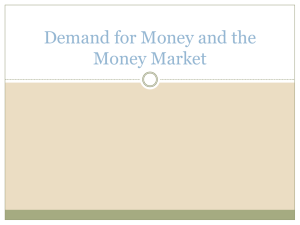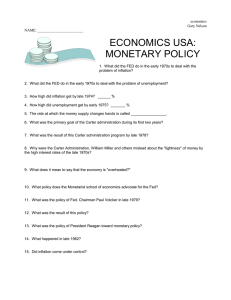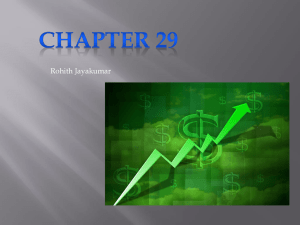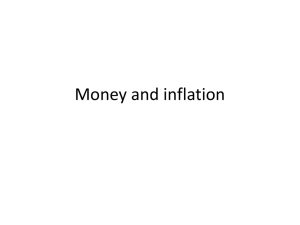The Fed at 100: Monetary Policy Performance and Central Banking
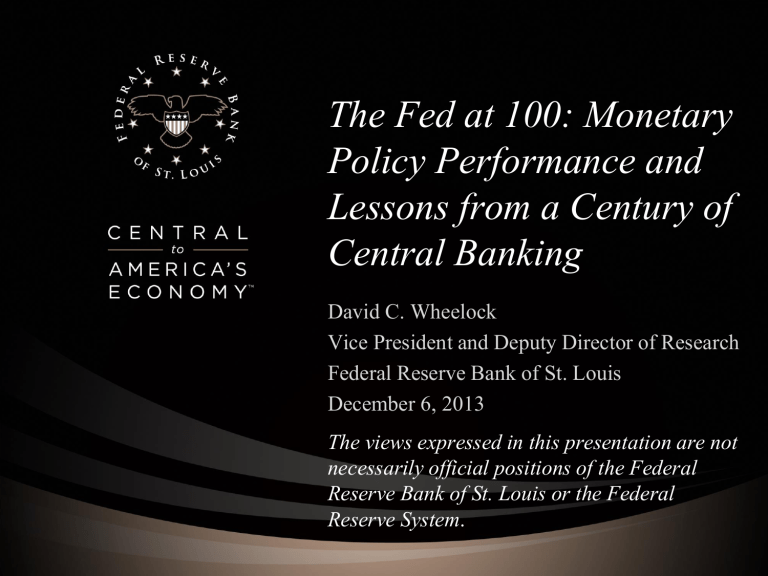
The Fed at 100: Monetary
Policy Performance and
Lessons from a Century of
Central Banking
David C. Wheelock
Vice President and Deputy Director of Research
Federal Reserve Bank of St. Louis
December 6, 2013
The views expressed in this presentation are not necessarily official positions of the Federal
Reserve Bank of St. Louis or the Federal
Reserve System .
End the Fed?
• The Fed’s response to the recent financial crisis was vigorous and controversial; monetary policy remains controversial
Need to distinguish crisis response (lender of last resort) from monetary policy response to the recession and beyond
The Fed now views financial stability and monetary policy as
“coequal” responsibilities of the central bank (Bernanke, 2013).
• How has Fed policy been shaped by events in the Fed’s first
100 years, especially the Great Depression and the Great
Inflation?
In the Beginning, Financial Stability was the Only Goal
• The Fed’s founders sought to prevent banking panics by
“furnishing an elastic currency.”
The Fed would “rediscount” commercial paper (loans) for member banks in exchange for currency (Federal Reserve notes) and reserve deposits.
The Fed supplied currency and reserves passively (against acceptable collateral) to satisfy demand.
• The founders did not conceive of monetary policy as we think of it today. The gold standard and adherence to “real bills” principles would ensure an optimal money supply (i.e., support economic activity without inflation).
The Great Depression
• A successful first 15 years, 1914-29
No crises
Price stability
Federal Reserve credit eliminated the seasonal fluctuations in interest rates
The Fed learned to use open-market operations to influence interest rates and achieve macro objectives, i.e., to conduct monetary policy
• But, then there was the Great Depression
Banking panics returned
Severe economic collapse with a prolonged recovery
The Great Depression and Great Recession
Period
1929-33
2007-09
Length in
Months
43
Real GDP:
Percent Decline
Peak to Trough
36.2%
Unemployment:
Max Value
During
Recession
25.4%
CPI: Percent
Change Peak to Trough
27.2%
18 4.7% 10.0% 1.6%
USD Billions
50
45
Banking Crises Brought Deflation
1929 Crash
Index, 1982-84=100
20
First Banking Panic
Second Banking Panic
UK off gold standard
18
40 16
Final Banking Panic
35 14
30
M2 (Left Axis)
CPI (Right Axis)
25
1929 1930 1931 1932 1933
Sources: National Bureau of Economic Research, Bureau of Labor Statistics & Haver Analytics
Last Observation: December 1933
12
10
The Fed’s Tepid Response to Crises
USD Millions
5000
Other Fed Credit
4500
Federal Reserve U.S. Govt. Securities Portfolio
4000
Federal Reserve Loans
3500
3000
U.K. Off Gold
Standard
2500
Stock Market
Crash
2000
First Banking
Panic
1500
1000
500
0
1929 1930 1931 1932
Sources: Federal Reserve Board, Banking and Monetary Statistics 1914-1941
Last Observation: December 1934
Final Banking
Panic
1933 1934
Where was the Fed?
Fed officials misinterpreted financial conditions: They viewed a lack of discount window borrowing and low nominal interest rates as evidence of monetary ease.
However, the discount window was closed to nonmember banks, required collateral, and entailed stigma
not a good signal of banking conditions
Deflation caused the real interest rate to rise, which increased the cost of borrowing and discouraged investment spending.
Low nominal rates reflected a collapsing economy, not monetary ease.
Deflation Caused Nominal and Real Interest Rates to Diverge
10
8
6
4
Percent, 3-Month Banker's Acceptance Rate
16
Nominal
14
Real
12
2
0
-2
1929 1930 1931
Real i = Nominal i – Inflation Rate
1932 1933
Last Observation: December 1933
Recovery: No Thanks to the Fed
Rapid money supply growth beginning in 1933 (Bank Holiday and deposit insurance ended banking panics; gold inflows increased the money supply; no Fed actions)
rising price level
falling real interest rate
increased spending
The Real Interest Rate and Business Investment
USD Billions
12
Treasury Bill minus Inflation Rate, Percent
14
10 11
8
6
4 2
2
Business Investment (Left Axis)
Real Interest Rate (Right Axis)
0
1929 1930 1931 1932 1933 1934 1935 1936 1937 1938 1939 1940 1941
-1
-4
Last Observation: 1941
8
5
USD Billions
65
M2 & Nominal GNP, 1929 - 1941
USD Billions (SA)
120
60
55
50
45
40
35 60
M2 (Left Axis)
30
Nominal GNP (Right Axis)
50
25
1929 1930 1931 1932 1933 1934 1935 1936 1937 1938 1939 1940 1941
40
Sources: National Bureau of Economic Research & Haver Analytics
Last Observation: December Q4-1941
80
70
110
100
90
Some Lessons from the Great Depression
•
Money matters
The central bank should respond aggressively to crises (lender of last resort);
The central bank should strongly resist deflation
•
Financial crises can have serious macroeconomic impacts
Recessions associated with financial crises tend to be more severe than others and recoveries are sluggish
More effort required to produce a vigorous recovery
Regime changes may be needed to restore confidence in banks and sustain recovery
More Mistakes: The Great Inflation
Percent
10
9
8
7
Inflation (Left Axis)
M2 Growth (Right Axis)
Percent
12
10
8
4
3
6
5 6
4
2
1
2
0
1951 1955 1959 1963 1967 1971 1975 1979 1983 1987 1991 1995
0
Source: Federal Reserve Board, Bureau of Labor Statistics & Haver Analytics
Last Observation: 1995
Where was the Fed?
•
Misled by nominal interest rates again – the real rate was low, sometimes negative, encouraging borrowing and spending. Monetary policy was not “tight.”
• Misled by the “Phillips Curve” – policymakers believed that unemployment could be reduced permanently by allowing a higher inflation rate.
•
Incorrect ideas about the causes of inflation (budget deficits, oil shocks, labor unions, etc.)
Nominal & Real Interest Rates
10
5
Percent
20
15
0
-5
Real Interest Rate
Nominal Interest Rate
-10
1965 1967 1969 1971 1973 1975 1977
Source: Federal Reserve Board, Bureau of Labor Statistics & Haver Analytics
Last Observation: December 1985
1979 1981 1983 1985
Phillips Curve 1959-68 & 1969-85
4
3
2
1
6
CPI Inflation Rate
5
0
-1
2 3
1968
1967
1966
4
1965 1960
1963
1964
1959
1962
5
Phillips Curve
1959-68
1961
6 7
Unemployment Rate
8
CPI Inflation Rate
14
Phillips Curve
1969-85
1980
12
10
1974
1979
1981
1975
8
6
4
2
3
1969
1973
1970
1972
1978
1971
1977
1976
1984
1985
4 5 6 7
1982
1983
8 9 10
Unemployment Rate
11
Source: Federal Reserve Board, Bureau of Labor Statistics & Haver Analytics
Last Observation: 1985
Lessons from the Great Inflation
•
Inflation is a monetary phenomenon (just as deflation was a monetary phenomenon in the 1930s)
•
The stance of monetary policy is reflected in the real interest rate, not the nominal rate (again, like the 1930s)
•
No long-run tradeoff between inflation and unemployment
Monetary policy cannot permanently lower the unemployment rate (long-run monetary neutrality)
Lessons Learned? Policy in 2007-09
• “Lender of Last Resort” (financial stability) actions:
Loan facilities for banks and other financial firms (TAF, PDCF, etc.)
Special facilities for specific firms (Bear Stearns, AIG)
“Stress Tests” for the largest firms (made permanent)
•
Monetary Policy actions:
Cut interest rates (ultimately to zero)
Forward guidance
Treasury and MBS purchases (“QE”)
•
No deflation; no depression
Looking Forward
•
•
The Fed drew lessons from prior crises, especially the Great
Depression, in 2007-09.
With inflation low, the Fed has also apparently avoided the mistakes of the Great Inflation, but much of the history of the current episode remains to be written.


